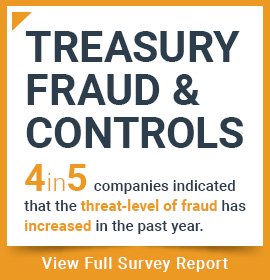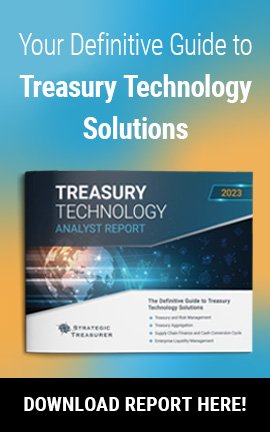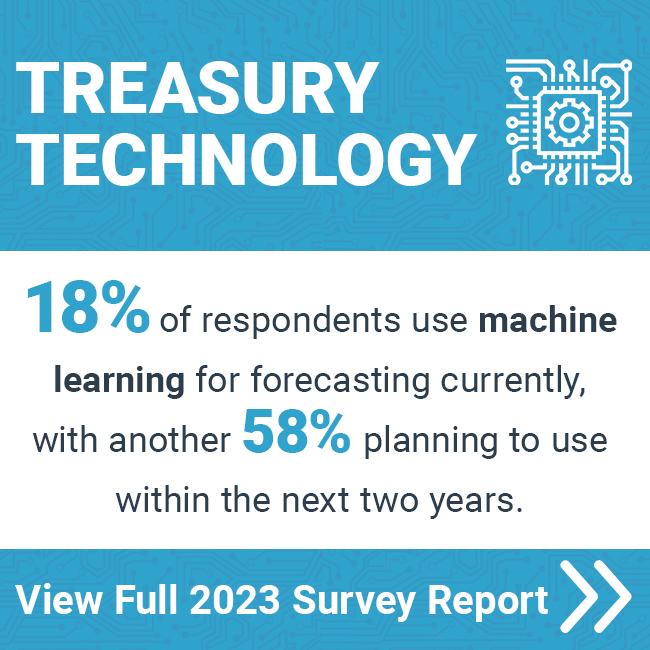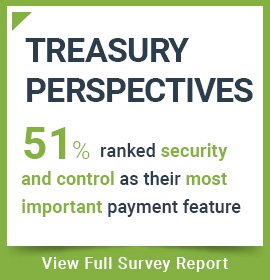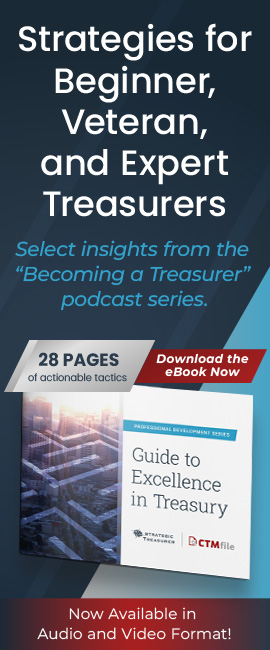
Episode 83
#GoStrategic Series:
Part 3 – Solving for Transparency with Merchant Cards
On part 3 of the #GoStrategic series, Host Craig Jeffery talks with Senior Treasury Consultant Stephanie Villatoro on the challenges of merchant card processing. They discuss why transparency to the fees are often misunderstood resulting in overlooked payments. Listen in and learn what you and your organization should look out for using this revenue collection stream.
Host:
Craig Jeffery, Strategic Treasurer


Speaker:
Stephanie Villatoro, Strategic Treasurer


Episode Transcription - Solving for Transparency with Merchant Cards (#GoStrategic Series)
Intro: Welcome to the Treasury Update Podcast presented by Strategic Treasurer. Your source for interesting treasury news, analysis and insights in your car, at the gym or wherever you decide to tune in.
On part three of the #GoStrategic series, host Craig Jeffery talks with Senior Treasury Consultant Stephanie Villatoro on the challenges of merchant card processing. They discuss why transparency to the fees are often misunderstood, resulting in overlooked payments. Listen in and learn what you and your organization should look out for using this revenue collection string.
Craig Jeffery: Welcome to the Treasury Update Podcast. This is Craig Jeffery, the Managing Partner of Strategic Treasurer and your host today. This is part of the #GoStrategic series. Today’s topic is merchant processing or merchant card processing and merchant processing is one of the areas that is the least understood in most organizations and the concept of getting transparencies to fees is a challenge. Many people don’t understand or misunderstand what’s going on and this results in organizations not reviewing what they are paying for this very important revenue collections stream. This fits into the overall structure. With me today and with me again is Stephanie Villatoro one of our senior advisors at Strategic Treasurer. Welcome to the Treasury Update podcast again, Stephanie.
Stephanie Villatoro: Thanks Craig.
Craig Jeffery: So in the context of the overall relationship, how does merchant processing fit in? How are we to think about, how should people think about merchant processing?
Stephanie Villatoro: So merchant card processing is one of several types of revenue collections. When you’re looking at how a company accepts payments card is one of those ones that you mentioned, it’s typically overlooked. It’s sometimes used or mostly used, I should say for some payments that are a challenge to receive by any other method. The other methods include check, ACH and wire.
Craig Jeffery: And when you say it’s, I know you say it’s overlooked, do you mean that people don’t spend time on it or it’s confusing or there’re misunderstandings about it, which means it’s not optimized?
Stephanie Villatoro: It’s overlooked because of the misunderstanding of the underlying fees of card and people don’t typically understand the underlying fees. They don’t want to use it because they think the fees for card transactions or receiving a card payment are too high.
Craig Jeffery: Then so are you making the case that that’s not always the point?
Stephanie Villatoro: It’s not always the point. Sometimes it is. It really depends on the business, how you process, as well as reviewing all of your collection streams and how the underlying fees are really associated with those. There’re many benefits to utilizing card payments and others as well.
Craig Jeffery: What are the benefits of using card as part of how you break up your payment stream? There’s fit somewhere for it in a lot of organizations. How do you look at that?
Stephanie Villatoro: Some of the typical benefits of using card payments over another method could be for customers who don’t pay on time or customers who have a lot of return checks and they move them into more of a card payment so it’s secured by the card association and then the risk it’s transferred to the card.
Craig Jeffery: No, that’s fair. And I know you and I’ve talked a number of times too about the situations where there’re certain types of customers. Even if they pay on time, it’s just not worth setting up trade credit for. It’s just too much effort, too high of a cost where you can streamline that entire process with card so it fits a certain strata of type of customers too. You know that concept of, do you look at all of your collection streams and review them and see what makes sense? What do you suggest for this type of review or stratifying what goes on and see where card fits? Is that something you recommend?
Stephanie Villatoro: Yes, especially if you’re looking at how and making changes in your current payment streams. If, you’re trying to remove a payment option from your revenue collection streams. For instance, a lot of companies are removing check from their collection stream or cash. Well, what is the replacement for those? Typically, if it’s small dollar like someone walking in and paying a fee. That’s $15 you’re going to move that from cash to card because what has happened in the atmosphere of fees for these different methods is coin and cash has become more and more expensive to process from a revenue standpoint than just moving those over to card or to another method.
Craig Jeffery: Stephanie, so some companies have a type of customer base that lends itself almost the entire customer base to settle via card. It’s very efficient. Maybe the amounts are low and it makes no sense to set up trade receivables or trade credit. Others have some kind of mix where part of their client base may make sense. Can you give us just some guidance in terms of how that may be stratified by type of industry or any other metrics that you would use to do that breakout?
Stephanie Villatoro: Certainly. So we see card utilized in many different industries, but it’s typically a primary payment option for companies that are more business to consumer or B to C. And we do see it in business to business as well for smaller business transactions, but in that B to C, it’s the things that you see every day when you’re buying food at a fast food restaurant or any type of restaurant for that matter, paying your utilities or building materials if you’re going to Home Depot or Lowe’s. In the B to B, that building materials also kind of comes into play for that business to business type of purchase order using cards for those orders. It’s much easier in that regard. You’re probably talking smaller businesses but it’s still is business.
Craig Jeffery: Thanks for that breakout. The other aspect that I wanted you to weigh in on, I fitted into my complex first question was how does card merchant activity fit into the overall relationship with your financial providers? There’s some complexity here and there’s some importance because it fits into the overall strategic element even though it’s down one level from it, but it has an important element there. Can you talk to that?
Stephanie Villatoro: When Treasury reviews their relationships for merchant card processing as a key component it’s typically in the share of wallet, which we talked about a little bit on our last podcast with bank fees. So merchant card fees is very similar to your bank transaction fees and that could be with a banking partner, someone who’s a strategic partner. It could also be a non-bank provider. There are many non-bank merchant card providers out there and some banks actually outsource to these where you have your relationship with the bank but they outsource to a third party processor. This is just one of those fee components to track as a subset on that share of wallet that are paid to your banking providers and where you have your spread of business.
Craig Jeffery: Maybe just taking a really quick side track for some of the people may not be familiar with all the terms, so the Visa, MasterCard, American Express, Discover, Europay, those are…
Stephanie Villatoro: Those are our card associations.
Craig Jeffery: Card associations. So the other ones where you’re talking about banking partner, a non-bank provider, those are the ones that provide, I think you referred to them as merchant services.
Stephanie Villatoro: There are merchant provider that can be just a processor. There are different terms that are used, but you can just think of it as the person in between the card association and the person making the payment that’s processing it on behalf of let’s say McDonald’s.
Craig Jeffery: And so these are the ones maybe you get a card from them that can settle with Amex, Visa, MasterCard through the terminal they provide.
Stephanie Villatoro: Yes, they’re providing the hardware to swipe, dip your card.
Craig Jeffery: Swipe or dip. Okay. Awesome.
Stephanie Villatoro: Do you want to know what dip is? That should be chip cards when you’re inserting it into a processor or into the hardware. That is what dip means.
Craig Jeffery: And it’s a long dip because it usually takes about three seconds or so to go through the process. That’s excellent Stephanie. When we think about the cash management element, which we spoke about in a prior episode on the Going Strategic, how does merchant differ from cash management? What are some of the key areas where they’re different? And maybe some of the points where they’re the same. I mean they’re both fees but go ahead.
Stephanie Villatoro: They are both fees but when you think of bank fees generally it is really just the volume for instance, or if we’re talking about wire payments, it’s how many wires you did that month multiplied by your contract rate and that’s your fee and that is what the bank receives as revenue for that service. Whereas card has multiple components because you have the card associations, you have the acquire bank, you have the processor and they all get a piece of the pie. So your total cost is there are multiple components in that. Would you like me to go through those a little bit?
Craig Jeffery: Well, sure. Without seeing a diagram. We’ll try it. I mean this is a podcast that people are hearing audibly, but hopefully they’re commuting or working out and they’re paying good mental attention. So go ahead and describe those.
Stephanie Villatoro: I’ll break it out to two different types. The one that you can actually negotiate versus the ones you cannot. So the nonnegotiable fees are what we call the card association fees that can be broken out into two separate fees. One, you probably have heard of are interchange fees. Interchange fees are paid to the issuing bank of the card that is swiped or dipped. These are set and they’re preset tables depending on the transaction and it is charged a fee based on that transaction and various components of it. And those tables are very long and very hard to understand, but that’s that fee. It’s a variable rate on the amount of the transaction. Then there’s also card brand fee. This is also called a card network fee, a card association fee, or even called an assessment on your statement. So they make it even more confusing by calling it different things depending on who’s giving you the statement. And these are typically just a flat fee per transaction and these are paid to the card associations. That is the Visa, MasterCard, Amex, so on and so forth out there.
Craig Jeffery: So this would be let’s say a 10 cent per debit card transaction for example or a card transaction.
Stephanie Villatoro: So yes, the card brand fee is a flat fee based on every transaction. So it could be the 10 cents per transaction that’s paid to the card associations. The other fee, interchange is a percentage of the dollar amount of the transaction. That combined is the total fee that is not negotiable.
Craig Jeffery: So there might be a value and then a percentage.
Stephanie Villatoro: Correct. The other type of fees are negotiable. These are your third party or your processor fees. That could be your bank or a third party processor. These are who you have the relationship with in order to take revenue collection payments via credit card. These could be different amounts from processor to processor. They can be flat rates based on transactions or they could be percentage rates or a combination of the two. It’s just different from one to one.
Craig Jeffery: Fair enough. So as we look at the challenges, what are some of the challenges and things to watch out for? And then I’d like you to explain them, but with a particular emphasis on how do you become strategic with that. How do you go strategic focus on the bigger items, but just talk through those if you would.
Stephanie Villatoro: So being strategic with your fees is the first is looking at all your different payment methods and identifying where it makes sense to take card versus another payment type. Knowing your costs and knowing your costs is one of the things that is the most challenging for companies out there because of the transparency into the different types of fees. What is negotiable, what is not negotiable. So, that is one of the bigger challenges. And then also one other thing to look out for is having that relationship with your merchant card processor to assist you in one, setting up your account correctly that you are tagged as the right merchant category code because that can change your level of processing and also in that level of processing different information that you’re transmitting for the payments can also impact your processing levels with the card associations. So those are ways to be strategic is keeping up on those and keeping up to date with those in case something changes.
Craig Jeffery: So the concept of depending on what information you transmit can have an impact on what the rate is. You transmit less information it might cost you more. The more you send in the lower rates you get. Is that fair?
Stephanie Villatoro: That’s fair. There’s many other components to it, but that is one component that impacts the rate or the table for which you’re charged against by each card association. It could be the card that’s actually being swiped. It could be the type of card. Rebate cards for instance to a standard card would have a higher interchange rate than a standard.
Craig Jeffery: The amazing complexity that’s built into all these things is surprising.
Stephanie Villatoro: Yes. It’s not a simple table. There’re varying components to it.
Craig Jeffery: Any final thoughts, Stephanie?
Stephanie Villatoro: My final thought for card processing is not to be afraid of it and to dig into it. Make sure you understand it. Maybe even look for experts in the field to help you understand what you are actually paying and how can you utilize it to the best of your benefit? Getting payments earlier for your cash cycle, minimizing your overall fees, not only for card but other payment types. It’s a useful tool for revenue collections that can be managed and minimize the overall cost.
Craig Jeffery: That’s really good advice. It’s certainly not a crime nor is there any shame in having, getting some assistance in this. Thank you, Stephanie, for participating in this episode of the Treasury Update podcast. The Treasury Going Strategic series.
Stephanie Villatoro: Thank you, Craig.
Outro: You’ve reached the end of another episode of the Treasury Update Podcast. Be sure to follow Strategic Treasurer on LinkedIn. Just search for Strategic Treasurer. This podcast is provided for informational purposes only and statements made by Strategic Treasurer, LLC on this podcast are not intended as legal, business, consulting or tax advice. For more information visit and bookmark strategictreasurer.com.
Related Resources
Check out our YouTube playlist covering many frequently asked questions in treasury!
#GoStrategic Series – A Treasury Update Podcast Series
A part of the Treasury Update Podcast, the #GoStrategic series covers a wide range of topics with a focus on how treasury organizations can go strategic. This includes freeing up the organization from operational activities in order to make more time for plans and activities that are considered strategic.


